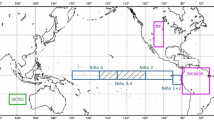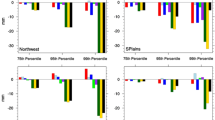Abstract
In this work we evaluate seasonal forecasts performed with the global environmental multiscale model (GEM) using a variable resolution approach and with a high-resolution region over different geographical locations. Therefore, using two grid positions, one over North America and the other over the tropical Pacific-eastern Indian Ocean, we compare the seasonal predictions performed with the variable resolution approach with seasonal forecast performed with the uniform grid GEM model. For each model configuration, a ten-member ensemble forecast of 4 months is performed starting from the first of December of selected ENSO winters between 1982 and 2000. The sea surface temperature anomaly of the month preceding the forecast (November) is persisted throughout the forecast period. There is not enough evidence to indicate that a Stretch-Grid configuration has a clear advantage in seasonal prediction compared to a Uniform-Grid configuration. Forecasts with highly resolved grids placed over North America have more accurate seasonal mean anomalies and more skill in representing near surface temperature over the North American continent. For 500-hPa geopotential height, however, no configuration stands out to be consistently superior in forecasting the ENSO related seasonal mean anomalies and skill score.


















Similar content being viewed by others
References
Barnston AG (1994) Linear statistical short-term climate predictive skill in the Northern Hemisphere. J Clim 7:1513–1564
Barnston AG, Livezey RE (1987) Classification, seasonality and persistence of low-frequency atmospheric circulation patterns. Mon Weather Rev 115:1083–1126
Bélair S, Crevier L-P, Mailhot J, Bilodeau B, Delage Y (2003) Operational implementation of the ISBA land surface scheme in the Canadian regional weather forecast model. Part I: Warm season results. J Hydrometeorol 4:371–386
Brankovic C, Palmer TN (1997) Atmospheric seasonal predictability and estimates of ensemble size. Mon Weather Rev 125:859–874
Brankovic C, Palmer TN, Ferranti L (1994) Predictability of seasonal atmospheric variations. J Clim 7:217–237
Côté J, Desmarais J-G, Gravel S, Méthot A, Patoine A, Roch M, Staniforth A (1998) The operational CMC-MRB global environmental multiscale (GEM) mode. Part I: Design considerations and formulation. Mon Weather Rev 126:1373–1395
Deque M, Piedelievre JPh (1995) High resolution climate simulation over Europe. Clim Dyn 11:321–339
Derome J, Brunet G, Plante A, Gagnon N, Boer GJ, Zwiers FW, Lambert S, Ritchie H (2001) Seasonal predictions based on two dynamical models. Atmosphere-Ocean 39:485–501
Derome J, Lin H, Brunet G (2005) Seasonal forecasting with a simple general circulation model: predictive skill in the AO and PNA. J Clim 18:597–609
Dima IM, Wallace JM (2003) On the seasonality of the Hadley cell. J Atmos Sci 60:1522–1527
Druyan LM, Fulakeza M, Lonergan P (2002) Dynamic downscaling of seasonal climate predictions over Brazil. J Clim 15:3411–3426
Fox-Rabinovitz MS, Takacs LL, Govindaraju RC, Suarez MJ (2001) A variable-resolution stretched-grid general circulation model: regional model simulation. Mon Weather Rev 129:453–469
Fox-Rabinovitz MS, Berebery EH, Takacs LL, Govindaraju RC (2005) A multiyear ensemble simulation of the US climate with a stretched-grid GCM. Mon Weather Rev 133:2505–2525
Fox-Rabinovitz MS, Cote J, Deque M, Dugas B, McGregor J (2006) Variable-resolution GCMs: stretched-grid model intercomparison project (SGMIP). J Geophys Res 111:D16104. doi:10.1029/2005JD006520
Goddard L, Mason SJ (2002) Sensitivity of seasonal climate forecasts to persisted SST anomalies. Clim Dyn 19:619–632
Goddard L, Mason SJ, Zebiak SE, Ropelewski CF, Basher R, Cane MA (2001) Current approaches to seasonal-to-interannual climate predictions. Int J Climatol 21(9):1111–1152
Hoerling MP, Kumar A, Zhong M (1997) El Niño, La Niña and the nonlinearity of their teleconnections. J Clim 10:1769–1786
Horel JD, Wallace JM (1981) Planetary-scale atmospheric phenomena associated with the Southern Oscillation. Mon Weather Rev 109:813–829
Hoskins BJ, Karoly DJ (1981) The steady linear response of a spherical atmosphere to thermal and orographic forcing. J Atmos Sci 38:1179–1196
Hurrell JW, Deser C (2009) North Atlantic climate variability: the role of the North Atlantic Oscillation. J Marine Syst (in press). doi:10.1016/j.jmarsys.2008.11.026
Jin EK, Kinter JL III, Wang B, Park C-K, Kang I-S, Kirtman BP, Kug J-S, Kumar A, Luo J-J, Schemm J, Shukla J, Yamagata T (2008) Current status of ENSO prediction skill in coupled O-A models. Clim Dyn 31:647–664. doi:10.1007/s00382-008-0397-3
Kain JS, Fritsch JM (1993) Convective parameterization for mesoscale models: the Kain–Fritsch scheme. The representation of cumulus convection in numerical models, meteorology monograph. Am Meteorol Soc 24:165–170
Kirtman BP, Zebiak SE (1997) ENSO simulation and prediction with a hybrid coupled model. Mon Weather Rev 125:2620–2641
Kumar A, Hoerling MP (1995) Prospects and limitations of seasonal atmospheric GCM predictions. Bull Am Meteorol Soc 76:335–345
Kumar A, Barnston AG, Peng P, Hoerling MP, Goddard L (2000) Changes in the spread of the variability of the seasonal mean atmospheric states associated with ENSO. J Clim 13:3139–3151
Li J, Barker HW (2005) A radiation algorithm with correlated-k distribution. Part I: local thermal equilibrium. J Atmos Sci 62:286–309
Lin H, Derome J (2004) Nonlinearity of the extratropical response to tropical forcing. J Clim 17:2597–2608
Lin H, Brunet G, Derome J (2008) Seasonal forecasts of canadian winter precipitation by postprocessing GCM integrations. Mon Weather Rev 136(3):769–783
Liu Z, Alexander M (2007) Atmospheric bridge, oceanic tunnel, and global climatic teleconnections. Rev Geophys 45:2
Markovic M, Lin H, Winger K (2010) Simulating global and North American climate using the global environmental multiscale model with a variable resolution modelling approach. Mon Weather Rev 138(10):3967–3987
Namias J (1978) Multiple causes of the North America abnormal winter 1976–1977. Mon Weather Rev 104:1225–1265
Nobre P, Moura AD, Sun L (2001) Dynamical downscaling of seasonal climate prediction over Nordeste Brazil with ECHAM3 and NCEP’s regional spectral models at IRI. Bull Am Meteorol Soc 82:2787–2796
Oort AH, Yienger JJ (1996) Observed variability in the Hadley circulation and its connection to ENSO. J Clim 9:2751–2767
Owen JA, Palmer TN (1987) The impact of El Niño on an extended range forecast. Mon Weather Rev 115:2103–2117
Palmer TN, Anderson DLT (1994) The prospects for seasonal forecasting. Q J Royal Meteorol Soc 120:755–793
Pielke RA Sr, Liston GE, Eastman JL, Lu L, Coughenour MB (1999) Seasonal weather prediction as an initial value problem. J Geophys Res 104:19463–19479
Quan X-W, Diaz HF, Hoerling MP (2004) Changes in the tropical Hadley cell since 1950. In: Diaz HF, Bradley RS (eds) The Hadley circulation: present, past, and future, advances in global change research, vol 21. Springer, New York, pp 85–120
Rowell DP (1998) Assessing potential seasonal predictability with an ensemble of multidecadal GCM simulations. J Clim 11:109–120
Rowell DP, Folland CK, Maskell K, Ward N (1995) Variability of summer rainfall over tropical North Africa (1906–1992): observations and modelling. Q J Roy Meteorol Soc 121:669–704
Shukla J (1998) Predictability in the midst of chaos: a scientific basis for climate forecasting. Science 282:728–731
Shukla J et al (2000) Dynamical seasonal prediction. Bull Am Meteorol Soc 81:2593–2606
Straus DM, Shukla J (2000) Distinguishing between the SST-forced variability and internal variability in mid-latitudes: analysis of observations and GCM simulations. Q J Roy Meteorol Soc 126:2323–2350
Straus DM, Shukla J (2002) Does ENSO force the PNA? J Clim 15:2340–2358
Sundqvist H, Berge E, Kristjansson JE (1989) Condensation and cloud parameterization studies with a mesoscale numerical weather prediction model. Mon Weather Rev 117:1641–1657
Taylor KE, Williamson D, Zwiers F (2000) The sea surface temperature and sea-ice concentration boundary conditions for AMIP II simulations. PCMDI report series #60, 28 pp
Troccoli A (2010) Review seasonal climate forecasting. Meteorol Appl. doi:10.1002/met.184
Uppala SM, Kallberg PW, Simmons AJ, Andrae U, Bechtold VD, Fiorino M, Gibson JK, Haseler J, Hernandez A, Kelly GA, Li X, Onogi K, Saarinen S, Sokka N, Allan RP, Andersson E, Arpe K, Balmaseda MA, Beljaars ACM, Van De Berg L, Bidlot J, Bormann N, Caires S, Chevallier F, Dethof A, Dragosavac M, Fisher M, Fuentes M, Hagemann S, Holm E, Hoskins BJ, Isaksen L, Janssen PAEM, Jenne R, McNally AP, Mahfouf JF, Morcrette JJ, Rayner NA, Saunders RW, Simon P, Sterl A, Trenberth KE, Untch A, Vasiljevic D, Viterbo P, Woollen J (2005) The ERA 40 re-analysis. Q J R Meteorol Soc 131:2961–3012
Waliser DE, Shia R-L, Lanzante JR, Oort AH (1999) The Hadley circulation: assessing NCEP/NCAR reanalysis and sparse in situ estimates. Clim Dyn 15(10):719–735
Wallace JM, Gutzler DS (1981) Teleconnections in the geopotential height field during the Northern hemisphere winter. Mon Weather Rev 109:784–812
Wang H, Schemm J-KE, Kumar A, Wang W, Long L, Chelliah M, Bell GD, Peng P (2009) A statistical forecast model for Atlantic seasonal hurricane activity based on the NCEP dynamical seasonal forecast. J Clim 22(17):4481–4500
Acknowledgments
We wish to thank Dr. Bernard Dugas from the Meteorological Research Division at Environment Canada, for his help in improving this work. We have benefited greatly from many discussions with Dr. Colin G. Jones from the Rossby Centre, Sweden. Many thanks to Juan Sebastian Fontecilla from the Canadian Meteorological Centre for providing the initial conditions for ensemble forecast simulations. This research was carried within the Canadian Regional Climate Modeling and Diagnostics (CRCMD) network, funded by the Canadian Foundation for Climate and Atmospheric Sciences (CFCAS) and Ouranos Consortium. Lin is partly supported by the CFCAS and the Natural Science and Engineering Research Council of Canada (NSERC) with projects related to tropical-extratropical interactions.
Author information
Authors and Affiliations
Corresponding author
Rights and permissions
About this article
Cite this article
Markovic, M., Lin, H. & Winger, K. Dynamical seasonal prediction using the global environmental multiscale model with a variable resolution modeling approach. Clim Dyn 39, 1885–1904 (2012). https://doi.org/10.1007/s00382-011-1202-2
Received:
Accepted:
Published:
Issue Date:
DOI: https://doi.org/10.1007/s00382-011-1202-2




